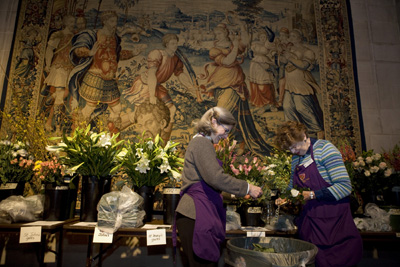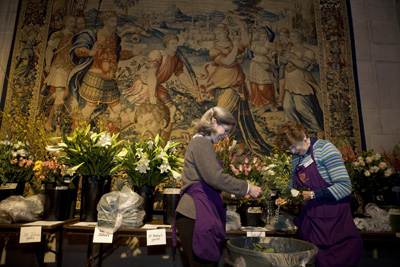
(RNS8-APR09) Altar guild volunteers Diane Cunningham, left, and Jean Bentz, right, group flowers in St. Mary’s Chapel ahead of Easter services at Washington National Cathedral. Religion News Service photo by David Jolkovski.

(RNS8-APR09) Altar guild volunteers Diane Cunningham, left, and Jean Bentz, right, group flowers in St. Mary’s Chapel ahead of Easter services at Washington National Cathedral. Religion News Service photo by David Jolkovski.
(RNS) To the untrained eye, the graceful lilies that arrive on church altars each year on Easter Sunday are a familiar symbol of resurrection and renewal. Like poinsettias on Christmas, it just wouldn’t be Easter without them.
But for the people who get them there — on a date that shifts from year to year — getting the trumpet-shaped flowers to bloom on cue takes months of just-right gardening, mathematical deduction and extreme diligence.
“It is by far the most complicated, single thing that happens in the floricultural industry,” said William B. Miller, professor of horticulture at Cornell University.
“Valentine’s Day — same day every year. Christmas Day — same day every year. No problem. … It’s extremely complicated and Easter lily growers really do have to keep very close track of this stuff. They have to very much manage their crop.”
Researchers like Miller have drawn up schedules for greenhouses with how-to instructions specific to the date Easter arrives in a given year, chronicling the steps once lily bulbs arrive in mid-October from bulb growers on the West Coast.
Week by week, the guidelines suggest the exact period for cooling the bulbs (six weeks), best greenhouse temperatures (somewhere in the 60s) and how long the buds should be at various points in the growing process.
Temperature is the secret to getting an Easter lily to bloom on time, said Norman White, owner of White’s Nursery and Greenhouses in Chesapeake, Va., who has grown lilies for about 40 years.
“You have to look at the plant, decide where it is in the stage of its growth and when Easter is and you make the decision,” he said. “Should you give it more heat or less heat, depending on the time Easter is?”
Even as the lilies go through the early cooling stage, known as “vernalization,” conditions have to be just right, said Ray Greenstreet, co-owner of Greenstreet Growers in Lothian, Md.
The lily bulb, packed in peat moss, “has to stay moist,” he said. “It can’t be too wet or too dry.”
His staff does intricate leaf counts to determine how many leaves need to unfold each day before the plant flowers. “You can’t be a couple days late or a couple of days early,” he said. “You really have to follow the recipe.”
Jeff den Breejen, vice president of Ednie Flower Bulbs in Fredon, N.J., has spent part of March traveling up and down the East Coast, visiting greenhouses and inspecting the still-growing lilies that will soon be shipped to stores.
“If they weren’t up to a certain amount of inches by that time, we told them to turn the heat up,” he said. “If they don’t make it for Easter, it’s not worth anything the week after Easter.”
If the flowers arrive late, he could lose customers who wouldn’t want to order them the next time around.
Growers say Easter’s rotating spot on the calendar affects what other crops they plant in a particular year. While this year Easter is early (April 4), some are already dreading next year when it falls much later, on April 24.
“Everybody is already thinking about what in the devil are we going to do with Easter so late?” said Russell Weiss, owner of Kurt Weiss Greenhouses in Center Moriches, N.Y. “A lot of growers next year will not grow Easter plants because it’ll interfere with their spring season.”
In fact, growers say sales of the estimated 9 to 10 million Easter lilies shipped across North America each year are either static or diminishing, with some churches no longer decorating with lilies, and younger generations less interested in buying them.
The biggest numerical drop in the industry is where it all begins — at the bulb stage.
“When I first came in the business in the mid- to late’70s, there were 26 lily bulbs growers,” said Rob Miller, owner of Dahlstrom and Watt Bulb Farms of Smith River, Calif., and brother of the Cornell University researcher.
Now, Miller says, he’s one of four.
At one time, shortly after World War II when lilies were no longer imported from Japan, hundreds of bulb growers tilled the soil from Half Moon Bay, Calif., to Bellingham, Wash., where conditions are perfect for growing the flowers.
Now, according to distributors and growers, large retail chains sell lilies at lower prices and with very strict specifications, which creates greater challenges for those on the growing end of the industry.
“The consistency of the product and the profitability of handling and growing has gotten extremely tight,” Rob Miller said. “And that’s what’s contributed to the continual decrease to the number of bulb growers.”
When Miller’s brother, the Cornell horticulturalist, arrives at the First Congregational Church of Ithaca, he suspects he’s the only person in the pews who appreciates everything that went into getting the flowers to the church on time.
“They have no idea,” William Miller said of fellow worshippers. “No clue.”




